| Solar eclipse of October 25, 2022 | |
|---|---|
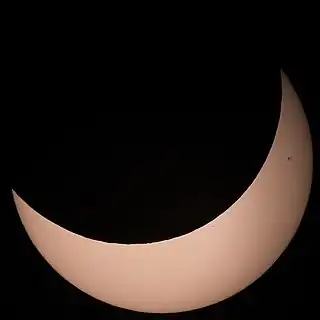 Partial from Saratov, Russia | |
 Map | |
| Type of eclipse | |
| Nature | Partial |
| Gamma | 1.0701 |
| Magnitude | 0.8623 |
| Maximum eclipse | |
| Coordinates | 61°36′N 77°24′E / 61.6°N 77.4°E |
| Times (UTC) | |
| Greatest eclipse | 11:01:20 |
| References | |
| Saros | 124 (55 of 73) |
| Catalog # (SE5000) | 9558 |
The solar eclipse of October 25, 2022, was a partial solar eclipse[1][2][3][4] visible from Europe, the Urals and Western Siberia, Central Asia, Western Asia, South Asia and from the north-east of Africa. The maximal phase of the partial eclipse occurred on the West Siberian Plain in Russia near Nizhnevartovsk, where more than 82% of the Sun was eclipsed by the Moon. In India, the Sun was eclipsed during sunset ranging from 58% in the north and around 2% in the south. From Western Europe it appeared to be around 15-30% eclipsed. It was visible between 08:58 UTC, the greatest point of eclipse occurred at 11:00 UTC and it ended at 13:02 UTC.
A partial solar eclipse occurs in the polar regions of the Earth when the center of the Moon's shadow misses the Earth.
Gallery
 Telescopic view from Milton Keynes, England, 10:02 UTC
Telescopic view from Milton Keynes, England, 10:02 UTC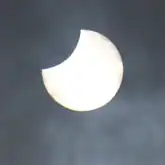 From Novate Milanese, Italy, 10:08 UTC
From Novate Milanese, Italy, 10:08 UTC From Lutkówka, Poland, 10:11 UTC
From Lutkówka, Poland, 10:11 UTC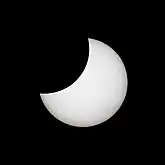 From Berlin, Germany, 10:24 UTC
From Berlin, Germany, 10:24 UTC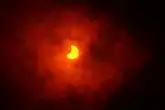 From Žilina, Slovak Republic, 10:39 UTC
From Žilina, Slovak Republic, 10:39 UTC.jpg.webp) From Moscow, Russia, 10:47 UTC
From Moscow, Russia, 10:47 UTC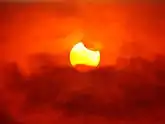 From Poltava, Ukraine, 10:48 UTC
From Poltava, Ukraine, 10:48 UTC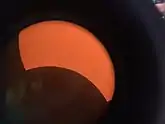 Telescopic view from Istanbul, Turkey, 11:02 UTC
Telescopic view from Istanbul, Turkey, 11:02 UTC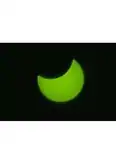 Observed in Kiryat Ata, Israel
Observed in Kiryat Ata, Israel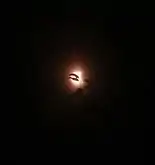 From Dushanbe, Tajikistan, 12:07 UTC
From Dushanbe, Tajikistan, 12:07 UTC From Bhubaneswar, India, 12:11 UTC
From Bhubaneswar, India, 12:11 UTC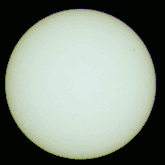 Animation from Belfort, France
Animation from Belfort, France- A transit of a bird during the eclipse from Kumbakonam, India
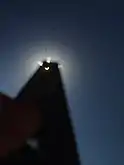
Related eclipses
Eclipses of 2022
Saros 124
Solar saros 124, repeating every about 18 years and 11 days, contains 73 events. The series started with partial solar eclipse on March 6, 1049. It contains total eclipses from June 12, 1211, to September 22, 1968, and a hybrid solar eclipse on October 3, 1986. The series ends at member 73 as a partial eclipse on May 11, 2347. The longest total eclipse occurred on May 3, 1734, at 5 minutes and 46 seconds.[5]
| Series members 43–59 occur between 1801 and 2100: | ||
|---|---|---|
| 43 | 44 | 45 |
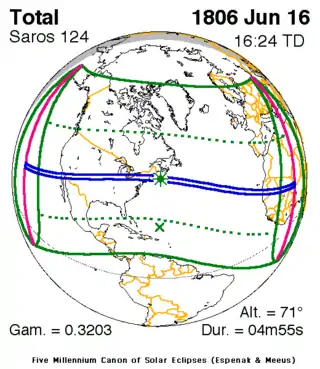 June 16, 1806 |
 June 26, 1824 |
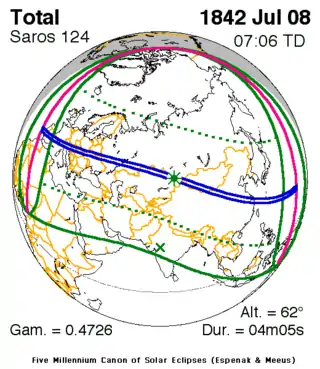 July 8, 1842 |
| 46 | 47 | 48 |
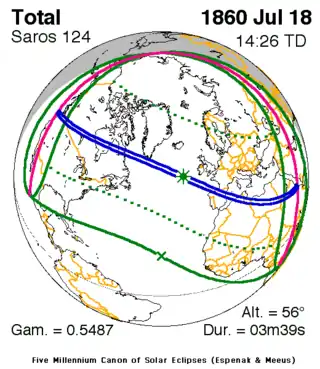 July 18, 1860 |
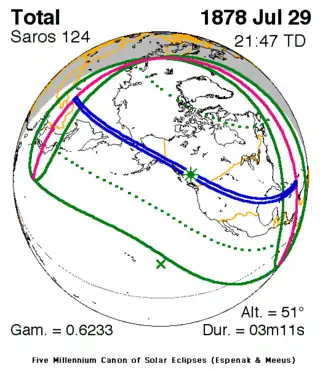 July 29, 1878 |
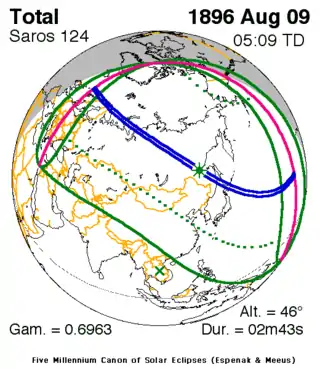 August 9, 1896 |
| 49 | 50 | 51 |
 August 21, 1914 |
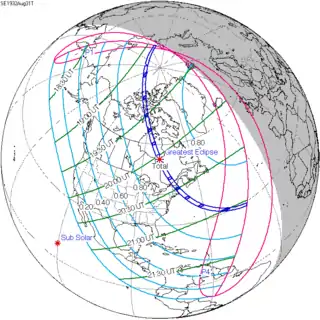 August 31, 1932 |
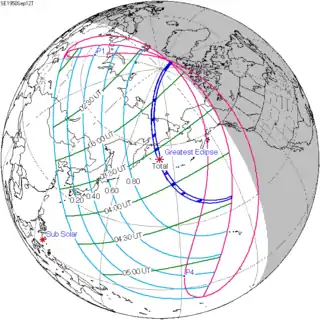 September 12, 1950 |
| 52 | 53 | 54 |
 September 22, 1968 |
 October 3, 1986 |
 October 14, 2004 |
| 55 | 56 | 57 |
 October 25, 2022 |
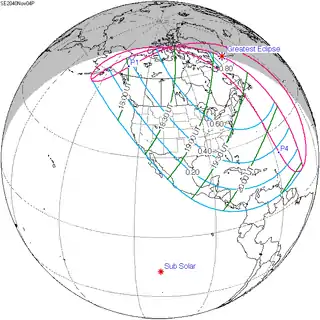 November 4, 2040 |
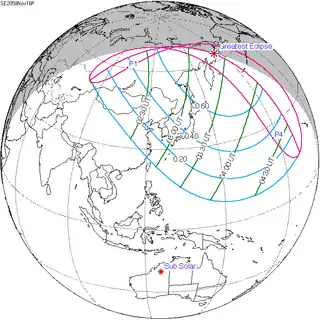 November 16, 2058 |
| 58 | 59 | |
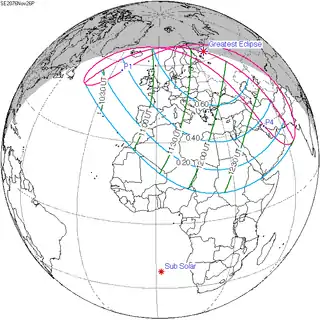 November 26, 2076 |
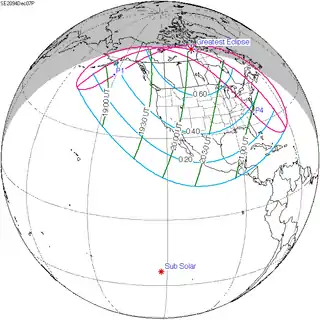 December 7, 2094 | |
Solar eclipses of 2022–2025
This eclipse is a member of a semester series. An eclipse in a semester series of solar eclipses repeats approximately every 177 days and 4 hours (a semester) at alternating nodes of the Moon's orbit.[6]
| Ascending node | Descending node | |||||
|---|---|---|---|---|---|---|
| Saros | Map | Gamma | Saros | Map | Gamma | |
119.tiff.jpg.webp) Partial from CTIO, Chile |
2022 April 30 Partial |
−1.19008 | 124 Partial from Saratov, Russia |
2022 October 25 Partial |
1.07014 | |
129 Total from East Timor |
2023 April 20 Hybrid |
−0.39515 | 134.jpg.webp) Annular from Campeche, Mexico |
2023 October 14 Annular |
0.37534 | |
| 139 | 2024 April 8 Total |
0.34314 | 144 | 2024 October 2 Annular |
−0.35087 | |
| 149 | 2025 March 29 Partial |
1.04053 | 154 | 2025 September 21 Partial |
−1.06509 | |
Metonic series
The metonic series repeats eclipses every 19 years (6939.69 days), lasting about 5 cycles. Eclipses occur in nearly the same calendar date. In addition, the octon subseries repeats 1/5 of that or every 3.8 years (1387.94 days). All eclipses in this table occur at the Moon's descending node.
| 21 eclipse events between June 1, 2011 and June 1, 2087 | ||||
|---|---|---|---|---|
| May 31 – June 1 | March 19–20 | January 5–6 | October 24–25 | August 12–13 |
| 118 | 120 | 122 | 124 | 126 |
 June 1, 2011 |
 March 20, 2015 |
 January 6, 2019 |
 October 25, 2022 |
 August 12, 2026 |
| 128 | 130 | 132 | 134 | 136 |
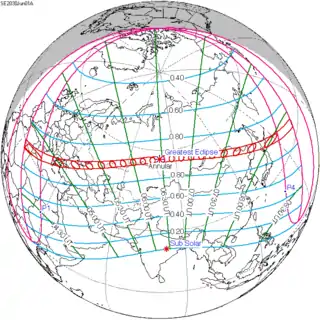 June 1, 2030 |
 March 20, 2034 |
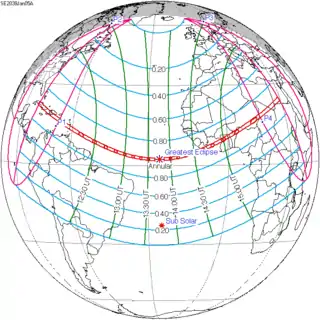 January 5, 2038 |
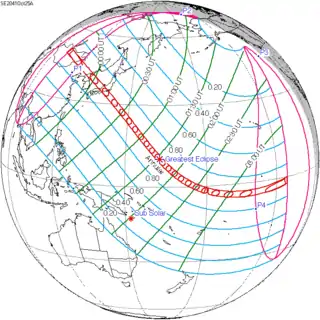 October 25, 2041 |
 August 12, 2045 |
| 138 | 140 | 142 | 144 | 146 |
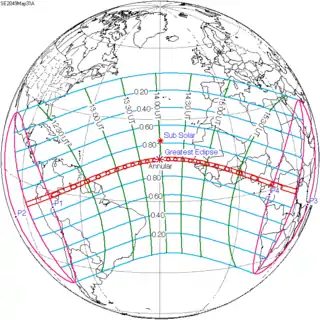 May 31, 2049 |
 March 20, 2053 |
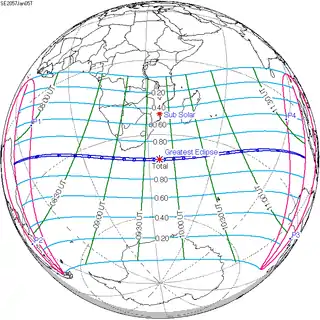 January 5, 2057 |
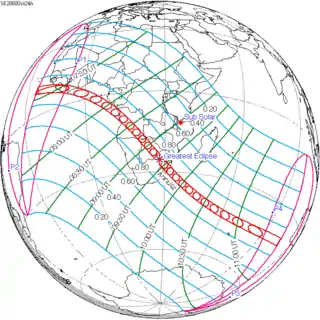 October 24, 2060 |
 August 12, 2064 |
| 148 | 150 | 152 | 154 | 156 |
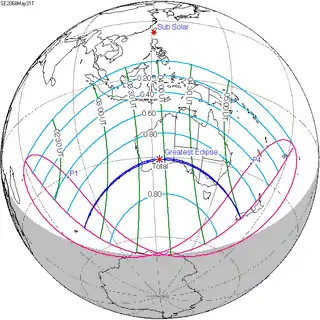 May 31, 2068 |
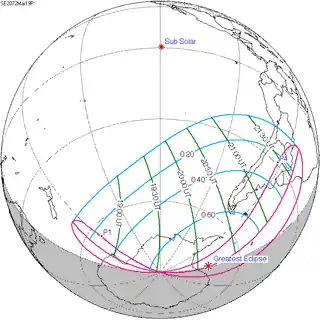 March 19, 2072 |
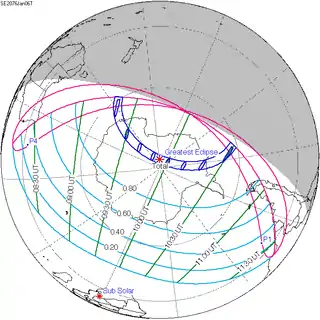 January 6, 2076 |
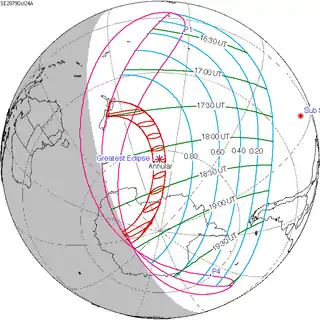 October 24, 2079 |
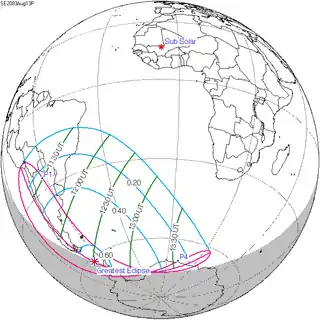 August 13, 2083 |
| 158 | 160 | 162 | 164 | 166 |
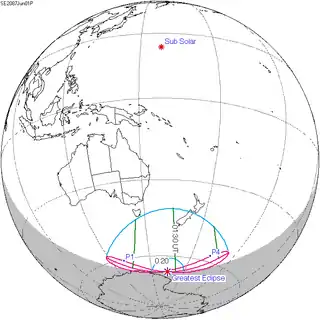 June 1, 2087 |
 October 24, 2098 |
|||
References
- ↑ "Surya Grahan 2022: Photos of October's Solar Eclipse, Captured From Mumbai, Chennai, Indore and Other Indian Cities | Weather.com". The Weather Channel.
- ↑ Archie, Ayana (October 25, 2022). "The last solar eclipse of the year happens today". NPR.
- ↑ Nicioli, Taylor (October 25, 2022). "The last solar eclipse of the year can be seen today". CNN.
- ↑ Fine, Camille. "Last solar eclipse of the year in photos: Marvel at this astronomical phenomenon". USA TODAY.
- ↑ Saros Series Catalog of Solar Eclipses NASA Eclipse Web Site.
- ↑ van Gent, R.H. "Solar- and Lunar-Eclipse Predictions from Antiquity to the Present". A Catalogue of Eclipse Cycles. Utrecht University. Retrieved 6 October 2018.
.jpg.webp)

